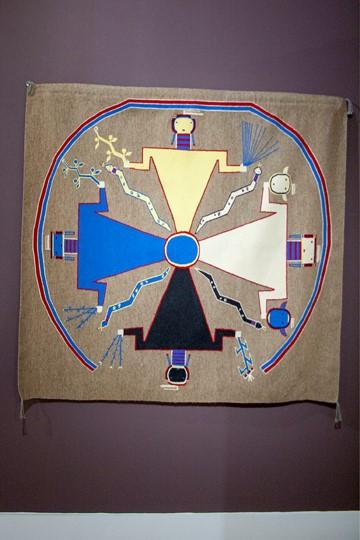
The Four Holy Times of Day (from the Coyote Way Chant)

The Four Holy Times of Day (from the Coyote Way Chant)
Anna Mae Tanner
1978
Bob: This sandpainting weaving is an intentionally imperfect picture of what a hathali (medicine person) would construct using colored sand in a healing ceremony. Sandpaintings are meant to be ephemeral and the sand is given to the winds after the painting is used—so to represent it precisely and in a permanent form would be disrespectful to the spirits and to the hathali’s ancestral teachers who shared it.
Henry: The four colors represent how the world has evolved and continues to evolve, woven with disorder and balance. The rainbow depicts the Holy People, who come to be part of the healing and use their songs to communicate to the Divine Beings for security and to restore the patient to health. The circle in the middle of the rug is the Universe. Navajos use the energy of the Universe for healing and to restore balance to live in harmony with the natural order.
Shimá: The four plants are tobacco, squash, beans, and corn. The four snakes are important. If we somehow hurt a snake, it affects our energy—your mind wanders and you forget your home and family. To restore and balance your energy, they use a sandpainting with snakes to heal you.
Bob: The number four, ninety-degree rotational symmetry, four-fold symmetry, four cornstalks, four clusters of leaves, etc., is reflected here.